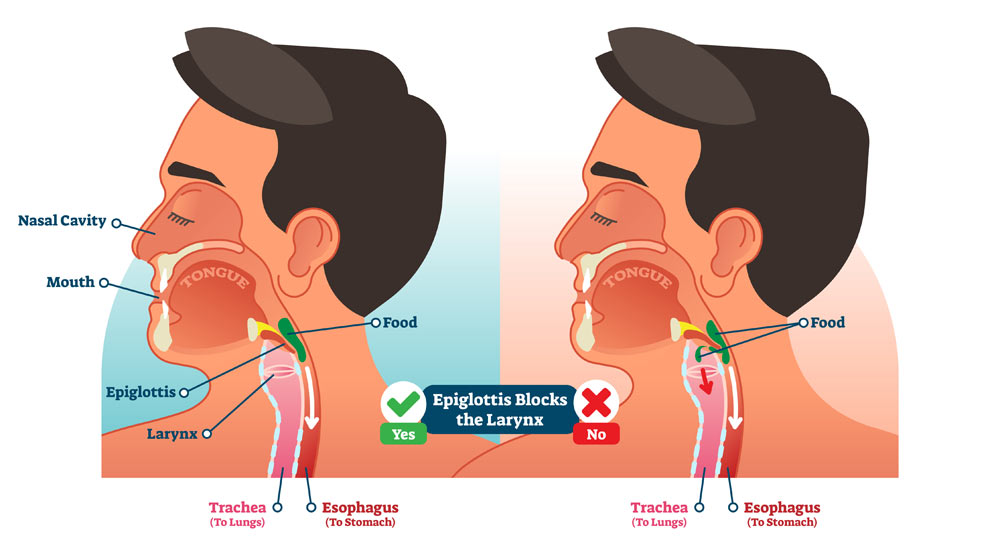There are various disorders that can affect the throat, both in terms of swallowing and speech.
The throat, more formally known as the pharynx, is a tube that carries food to another tube known as the esophagus and air to another tube known as the larynx.

Almost everyone has experienced a sore throat at some point in their life. A sore throat is a good example of a minor throat problem that can occur as the result of a virus. Beyond a sore throat, however, there are other conditions that can affect the throat.

Did You Know?
The epiglottis is a thin flap of tissue that sits above the larynx. It’s main function is to push food into the esophagus and prevent food from entering the windpipe (airway).
Dysphagia
Dysphagia is the medical term for difficulty swallowing foods and/or liquids. There are two main types of dysphagia known as oropharyngeal and esophageal:
Oropharyngeal is caused by problems with nerves and muscles in the throat that cause choking or gagging while swallowing. Oropharyngeal dysphagia can be caused by:
- Esophageal cancer
- Multiple sclerosis
- Nerve damage
- Obstruction in the upper throat, pharynx, or pharyngeal pouches
- Parkinson’s disease
- Post-polio syndrome
Esophageal dysphagia
Esophageal dysphagia is characterized by the feeling that something is stuck in your throat and can be caused by:
- Foreign bodies lodged in the esophagus or throat
- Spasms in the lower esophagus
- Swelling or narrowing of the esophagus from inflammation or GERD
- Narrowing of the esophagus from growths or scarring
- Tightness in the lower esophagus due to narrowing of the esophageal ring
- Scar tissue in the esophagus from chronic inflammation or radiation treatment
Treatment for dysphagia varies depending on the cause and severity of the problem. Some cases may only require dietary modifications, while others may require prescription medications and/or surgical intervention. Surgical intervention is generally required to remove growths or scar tissue, or to perform esophageal dilation to expand the esophagus.
Tonsillitis and Adenoiditis
The tonsils are located in the back of the throat, while the adenoids are located in the throat behind the nose and the roof of the mouth. Both structures are part of the immune system and both can cause problems when they become infected and/or are too large. Treatment usually start with antibiotics, however, recurring cases may be treated with the removal of the problematic structure
Laryngitis/Hoarseness
Laryngitis is an inflammation of the voice box that affects how airflow sounds moving into the throat. Most causes of laryngitis are acute and cause a brief hoarseness that lasts about a week or two. However, chronic laryngitis is any case lasting longer than 3 weeks. Chronic laryngitis generally occurs when the vocal cords have become injured or strained.
Vocal Cord Dysfunction
Vocal cord dysfunction is a generalized term used to describe a neuropathy in the vagus nerve that causes a feeling of constantly having a lump in one’s throat. It can also include:
- Chronic throat clearing due to the constant sensation of throat irritation due to faulty nerve signals
- Neurogenic cough, which occurs as a result of nerve irritation instead of inflammation or infection
- Paradoxical True Vocal Cord Movement, sometimes called exercise induced asthma, is when the vocal cords close when they should be opening.

Vocal cord dysfunction is generally treated by first removing any irritants, then using medications to decrease the damaged nerves from constantly signaling.
The Diagnostic Process
Comfortable and Relaxing
At Anne Arundel ENT & Facial Plastic Surgery, we use a state of the art technique known as videostroboscopy to accurately diagnose conditions that affect the vocal cords.
During a videostroboscopy, a speech-language pathologist will place a small, angled scope in your mouth or nose.
They will then ask you to vocalize several words and sounds, all of which will make your vocal cords vibrate.
The entire process only takes a few minutes and does not cause any pain.
Your doctor will then evaluate the information obtained from the examination and a treatment plan will be recommended. Treatment for vocal cord conditions can include medications, vocal exercises, speech therapy, and surgical intervention.
Throat, swallowing, and voice disorders can cause a variety of complications, depending on what structures they affect and the extent of the problem. While most throat disorders are minor, it is important to have chronic throat problems evaluated to prevent the problem from getting worse.



